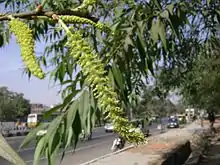Salix tetrasperma
Salix tetrasperma, commonly called Indian willow, is a medium-sized tree of wet and swampy places, shedding its leaves at the end of monsoon season. It flowers after leafing. The bark is rough, with deep, vertical fissures and the young shoots leaves are silky. The leaves are lance-like, or ovate-lancelike, 8–15 cm long, with minutely and regularly toothed margins. The male sweet scented catkins are 5–10 cm long, and are borne on leafy branchlets. The female catkins are 8–12 cm long. The capsules are long, stipulate, in groups of 3 to 4.
| Salix tetrasperma | |
|---|---|
 | |
| Indian Willow blooming in Delhi. | |
| Scientific classification | |
| Kingdom: | Plantae |
| Clade: | Tracheophytes |
| Clade: | Angiosperms |
| Clade: | Eudicots |
| Clade: | Rosids |
| Order: | Malpighiales |
| Family: | Salicaceae |
| Genus: | Salix |
| Species: | S. tetrasperma |
| Binomial name | |
| Salix tetrasperma Roxb. | |
| Synonyms[1] | |
| |
It grows in many parts of south and southeastern Asia, including India, Pakistan, Bangladesh, Nepal,[2] Laos, and Thailand,.[3]
In Manipur, in NE India, the new flowers of Indian willow, locally known as ঊযুম (ooyum) are eaten, and are considered delicious. In Maharashtra, this tree is called walunj. It can be found in Pune, Satara, Sangli, and Kolhapur. In Nepal, it is called Bainsa(बैँस).

References
- "Salix tetrasperma Roxb". World Flora Online. The World Flora Online Consortium. 2022. Retrieved 3 August 2022.
- Jackson, J.K. Manual of afforestation in Nepal. Kathmandu: Forest Research and Survey Center, 1994
- Gardner, Simon, Pindar Sidisunthorn, and Vilaiwan Anusarnsunthorn. A Field Guide to Forest Trees of Northern Thailand. Bangkok: Kobfai Publishing Project, 2000.